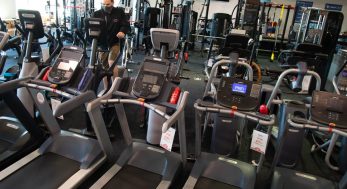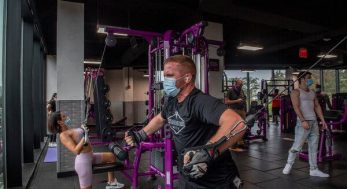Research shows that simple and low-effort exercises can have a big impact on your fitness, writes Peta Bee.
Spending hours at the gym each week will undoubtedly pay off. But who has that much time and energy to spare? In reality, most of us struggle to stick to a fitness routine… So it’s great news when experts tell us we can tone up with some exercises which require very little movement at all.
According to the Galway-based fitness trainer Pat Divilly, accumulating minimal movement throughout the day is hugely beneficial.
“The secret to health and longevity lies in consistent activity throughout the week as opposed to two to three intense training sessions,” Divilly says. So, what are the subtle exercises that will make a difference to your health and fitness? Here, we review the latest findings:
SQUEEZE YOUR GLUTES
You can spend €30 a session firming your glutes in a Pilates or gym class, or you can just squeeze your glutes as you sit or stand. A study published earlier this summer in PeerJ, the Journal of Life and Environmental Sciences, described how scientists at Wichita State University put the simple glute squeeze exercise — which required them to sit up straight and squeeze their glutes as hard as they could for five seconds before relaxing and repeating — to the test in order to find out if it had any effect on improving strength and buttock firmness.
In the trial, 32 volunteers were randomly assigned to perform either 15 minutes of gluteal squeezes a day or glute bridges — in which you lie on the floor and squeeze your glutes to raise your hips up so that your body forms a straight line from knees to shoulders — for the same duration.
Subjects were instructed to sit so that hips and knees were at right angles with knees shoulderwidth apart, and the feet touching.
It didn’t matter how they accumulated their 15 minutes per day of buttock squeezing — in one go or in several short bouts. But the results showed that, while all had similar improvements in tests of muscle endurance and jumping power, the gluteal squeezers had increased their gluteal or hip extension strength by 16% compared to only an 11% improvement for those doing the glute bridge exercise.
The researchers concluded that there are “clinical and aesthetic reasons to perform gluteal squeezes” as the girth of the glute muscles also increased more significantly in the squeeze group.
TRY BOX BREATHING
Divilly says the way we breathe is hugely important. “I’m a huge fan of the box breath, a simple way of slowing things down and moving from fight-or-flight to rest and digest,” he says. “To do it, simply breathe in through the nose for a count of four, hold for four, exhale for four and then hold for a further four. Repeat for four breaths and notice the difference in your energy and calm. It only takes a minute and can be the perfect way to manage acute stressors throughout the day.”
HAVE A BELLY LAUGH
A study published in the Journal of Motor Behaviour (2014) reported how laughter provides a good workout for the core, imposing “an increased demand on trunk muscles”. A team of researchers in Germany measured the activation level of five trunk muscles when people laughed (during a laughter yoga class) with how hard the same muscles worked in traditional crunch and back-lifting exercises.
They found that activation of the external oblique muscles that extend from lower half of the ribs around and down to the pelvis on each side of the trunk was the same as when subjects performed crunch and back-lifting exercises.
Other trunk muscles — including the multifidus, erector spinae, and rectus abdominis muscles were activated about half as much during laughter than when subjects performed exercises.
Last year, researchers at the Centre for Interdisciplinary Science at the University of Leicester revealed that laughing “stimulates many muscles within the body” but that a 30-year-old man with a body fat percentage of 29% would need to laugh continuously for 19.7 hours to reduce his body fat to 1%, “the minimum value required for a visible sixpack”, and a further 84 minutes for high abdominal definition.
STAND UP EVERY HOUR
We are a hugely sedentary population and it is not helping our health. In 2016, research by the Irish Department of Health found that 26% of the population is sedentary, spending eight or more hours sitting during a typical day.
Last year, a team of researchers at Queen’s University Belfast and Ulster University reported that spending too much time sitting down contributes to an increased risk of cardiovascular disease, type 2 diabetes, cancer and early death.
Divilly says there are simply steps to take that will help to offset the sitting risks.
“Try setting an alarm or prompt that encourages you to get up on the hour each hour,” he says. “If you can take a quick stroll that will help you move toward a daily step count of 10,000 steps, that’s great, but just standing and moving is better than sitting down.”
SUCK IN YOUR STOMACH
It looks bizarre, but hollowing out and sucking in — or vacuuming— your stomach can help you to get an impressively flat and toned torso. Experts say it activates the transverse abdominis, the muscle that wraps around the torso and acts like a corset on the midsection. Dalton Wong, fitness adviser to Jennifer Lawrence, recommends all his clients do it for at least a minute every day. It’s best performed sitting or standing in a bent-over position.
The idea is to breathe in deeply and exhale forcefully as you suck in your belly button towards your spine. Hold the contraction (but not your breath) for 20 to 60 seconds, relax and repeat three to four times.
TRY THE ONE STRETCH
Studies from the University of Arkansas show that around 50% of people experience back pain after prolonged periods of standing in queues, at concerts or at work — even at a standing desk. When we stand, we subconsciously relax into poor posture with feet rolled inwards, shoulders rounded and tummy sticking out.
“Ultimately this can lead to pain in the lower back,” says Divilly.
Think about standing as tall as you can and try performing the One Stretch for better back health. A 2015 study by Japanese researchers in the Journal of Manual and Manipulative Therapy found that daily practice of this movement reduced low back pain in workers. Here’s how to do it… Stand with feet shoulder-width apart and place your hands firmly on your lower back, fingers pointing towards the floor. Breathe in and then exhale for three seconds as you gently stretch backwards, keeping the legs straight.
Keep your hands in place as you return to the start position and repeat several times a day.



